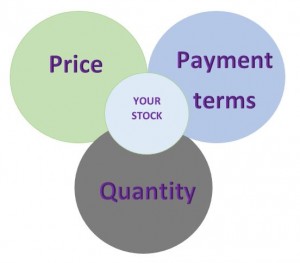Buying products and services
Creating a unique selling point
Your business, with its products or services, need a unique selling point and this should reflect the values and interests of yourself. It should also be of interest and generate excitement within you as you need to ensure you sell products and services which you are passionate about.
This passion will help you to sell and develop the products to your customer segments, in a profitable and fulfilling way. You also need to enjoy selling and running the business, so finding a product you are interested in is important – running a retail business is a 24/7 commitment, so you need to have a passion for the products you sell and the customers you serve. Once you have chosen your unique selling point with a product or service range, one that is based on your understanding of your customer segments, you need to get to know and understand what makes your product or service unique – what are the benefits of your product or service versus your competitors.
 Why should a customer buy your product or service versus that of your competition? Is yours exclusive? New? Better quality? Cheaper? Part of a theme/collection? Fashionable? Practical? etc.
Why should a customer buy your product or service versus that of your competition? Is yours exclusive? New? Better quality? Cheaper? Part of a theme/collection? Fashionable? Practical? etc.
You must understand what your product or service (or potential product or service) offers your customers that is different
A USP (Unique Selling Point/Proposition) is the general term that describes why your product or service is for sale and what your customer will receive when they buy your product or experience your services. The easiest way to think of this is: what are the benefits of the product or service to your target customer segments?
All products and services are different in some way, even generic products or services can be retailed differently, with different retail propositions and services – again, understanding your customer segment will drive the USP for your products.[/vc_column_text][vc_column_text title=”Understand your product’s USP”]Part of the getting to know and plan your product, and eventually creating your unique selling point or USP, is understanding the sourcing strategy – the process whereby you work out how to get the finished product to your retail outlet/warehouse. This could go back as far as production and you could be part of designing and producing the product yourself or outsourcing the production.
Sourcing (also known as the supply chain) is the process by which you find, manufacture or produce the products you wish to retail. This could be as simple as finding a local wholesaler or as complex as sourcing the raw materials and manufacturing your own products or services.
1. Low Quality = High Volume = Low Price –  You need to sell a large volume of low-priced, low-quality items to make a return, but you will adjust down your customer service and added value services accordingly.
You need to sell a large volume of low-priced, low-quality items to make a return, but you will adjust down your customer service and added value services accordingly.
2. Medium Quality = Medium Volume = Medium Price – Mid-range retailers and businesses sell a good quality product at a good price and achieve a good volume.
3. High Quality = Low Volume = High Price – The higher the price and quality, the lower the volume.
Develop your range and review your existing range or products or services”]
Think about the range as a customer segment – what will they want to see in the range? How will you lay out the range? Will it be a seasonal product range? Look at the range in total. For example, if you decided to sell laptops, think about the full range and all the accessories and related products you will need; with a laptop you will need a mouse, camera, carrying-case and maybe even a printer. Providing the customer with a total experience will be very beneficial, and very lucrative if you give the customer a full service offer of products and related products.
Remember…
People don’t buy what you sell
They buy what you stand for!
 Peak Insight
Peak Insight

